
Am Fam Physician. 2016;93(9):756-762
Related letter: Interpreting the Statistics on Potential Benefits of Prostate Cancer Screening
Author disclosure: Dr. Ebell is cofounder and editor-in-chief of Essential Evidence Plus, published by Wiley-Blackwell, Inc. Dr. Grad has no relevant financial affiliations.
In 2015, a group of primary care clinicians with expertise in evidence-based practice performed monthly surveillance of more than 110 English-language clinical research journals. They identified 251 studies that addressed a primary care question and had the potential to change practice if valid (patient-oriented evidence that matters, or POEMs). Each study was critically appraised and disseminated to subscribers via e-mail, including members of the Canadian Medical Association who had the option to use a validated tool to assess the clinical relevance of each POEM and the benefits they expect for their practice. This article, the fifth installment in this annual series, summarizes the 20 POEMs based on original research studies judged to have the greatest clinical relevance for family physicians. Key recommendations include questioning the need for backup throat cultures; avoiding early imaging and not adding cyclobenzaprine or oxycodone to naproxen for patients with acute low back pain; and encouraging patients with chronic or recurrent low back pain to walk. Other studies showed that using a nicotine patch for more than eight weeks has little benefit; that exercise can prevent falls that cause injury in at-risk older women; and that prostate cancer screening provides a very small benefit, which is outweighed by significant potential harms of screening and associated follow-up treatment. Additional highly rated studies found that tight glycemic control provides only a small cardiovascular benefit in patients with type 2 diabetes mellitus at the expense of hypoglycemic episodes; that treating mild hypertension can provide a modest reduction in stroke and all-cause mortality; that sterile gloves are not needed for minor uncomplicated skin procedures; that vasomotor symptoms last a mean of 7.4 years; and that three regimens have been shown to provide the best eradication rates for Helicobacter pylori infection.
Since 1994, a group of primary care clinicians with expertise in evidence-based practice has performed monthly surveillance of more than 110 English-language research journals.1 Of approximately 20,000 research studies published during 2015 in these journals, 251 met prespecified criteria for validity, relevance, and practice change. A study was considered valid if it was well designed and avoided important biases such as failure to conceal allocation or failure to mask outcome assessment. Relevance depended on the research question (i.e., is it relevant to a primary care clinician?) and on the outcomes reported; only studies that reported patient-oriented outcomes, such as morbidity, mortality, or quality of life, were considered relevant. Finally, studies with the potential to change practice for a substantial number of physicians were prioritized over those that merely confirmed existing practice (i.e., they matter). Studies that meet all of these criteria are called POEMs, for patient-oriented evidence that matters.2 Each POEM is summarized in a structured critical appraisal written by one of the six expert reviewers and peer reviewed by faculty and fellows of the University of Missouri Department of Family Medicine. Writing and disseminating the POEMs is supported by subscriptions, without industry support.
Since 2005, the Canadian Medical Association has sponsored a subscription to POEMs for its members. Each member has the option to receive the daily POEM by e-mail, and the option to rate it using a brief survey through the Information Assessment Method. The questionnaire for the Information Assessment Method is a validated tool that addresses relevance to clinicians, cognitive impact, use for practice, and expected health benefits if the results of the POEM would be applied.3 For this article, we identified the 20 POEMs of 2015 that were rated highest for clinical relevance by Canadian Medical Association members. Each POEM was rated by at least 500 physicians, and at least 52% of respondents rated each of these top 20 POEMs as “totally relevant for at least one of your patients,” whereas less than 18% rated each as “not relevant for at least one of your patients.”
In the fifth installment of this annual series,4–7 we summarize the clinical question and bottom-line answer for each of the 20 POEMs critically appraising an original research study, organized by topic and followed by a brief discussion. The bottom-line answers have been rewritten slightly from the original to stand alone without the complete synopsis and appraisal. We also briefly discuss POEMs summarizing practice guidelines that were judged to be highly relevant.
Respiratory Tract Infection
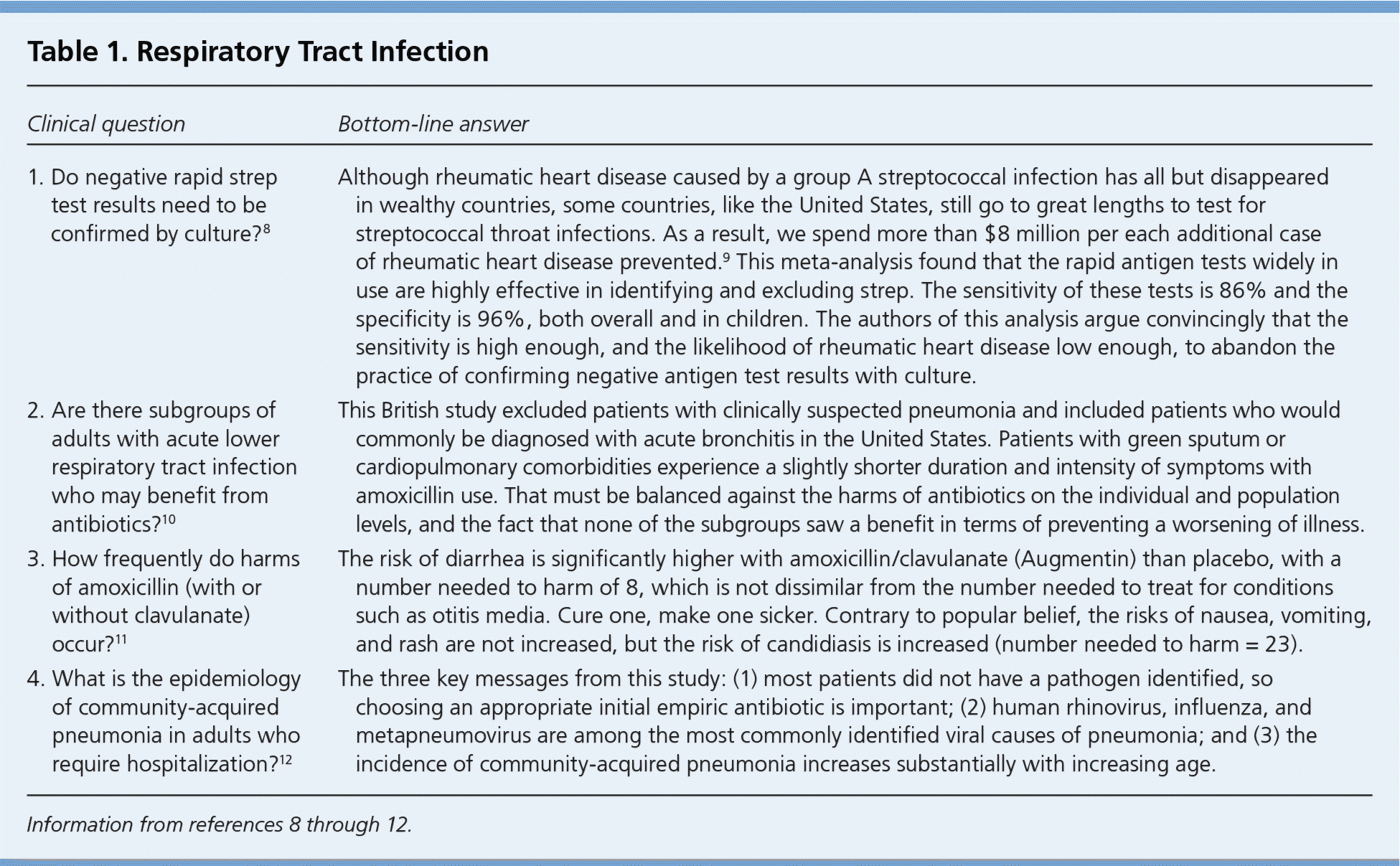
| Clinical question | Bottom-line answer |
|---|---|
| 1. Do negative rapid strep test results need to be confirmed by culture?8 | Although rheumatic heart disease caused by a group A streptococcal infection has all but disappeared in wealthy countries, some countries, like the United States, still go to great lengths to test for streptococcal throat infections. As a result, we spend more than $8 million per each additional case of rheumatic heart disease prevented.9 This meta-analysis found that the rapid antigen tests widely in use are highly effective in identifying and excluding strep. The sensitivity of these tests is 86% and the specificity is 96%, both overall and in children. The authors of this analysis argue convincingly that the sensitivity is high enough, and the likelihood of rheumatic heart disease low enough, to abandon the practice of confirming negative antigen test results with culture. |
| 2. Are there subgroups of adults with acute lower respiratory tract infection who may benefit from antibiotics?10 | This British study excluded patients with clinically suspected pneumonia and included patients who would commonly be diagnosed with acute bronchitis in the United States. Patients with green sputum or cardiopulmonary comorbidities experience a slightly shorter duration and intensity of symptoms with amoxicillin use. That must be balanced against the harms of antibiotics on the individual and population levels, and the fact that none of the subgroups saw a benefit in terms of preventing a worsening of illness. |
| 3. How frequently do harms of amoxicillin (with or without clavulanate) occur?11 | The risk of diarrhea is significantly higher with amoxicillin/clavulanate (Augmentin) than placebo, with a number needed to harm of 8, which is not dissimilar from the number needed to treat for conditions such as otitis media. Cure one, make one sicker. Contrary to popular belief, the risks of nausea, vomiting, and rash are not increased, but the risk of candidiasis is increased (number needed to harm = 23). |
| 4. What is the epidemiology of community-acquired pneumonia in adults who require hospitalization?12 | The three key messages from this study: (1) most patients did not have a pathogen identified, so choosing an appropriate initial empiric antibiotic is important; (2) human rhinovirus, influenza, and metapneumovirus are among the most commonly identified viral causes of pneumonia; and (3) the incidence of community-acquired pneumonia increases substantially with increasing age. |
Four studies addressed the management of acute respiratory tract infection (Table 1).8–12 Study 1 was a systematic review of the accuracy of rapid strep tests for streptococcal pharyngitis, and concluded that their accuracy is improving, with a sensitivity of 86%.8 Because these tests miss only about one in six cases of streptococcal pharyngitis, the yield of backup cultures is small, particularly in adults, in whom strep is less common. Study 2 is from a British research group that has conducted a series of large trials of antibiotics for acute lower respiratory tract infection when pneumonia is not suspected.10 The authors randomized 2,061 adults to receive amoxicillin, 1 g three times daily for seven days, or placebo (susceptibility of common respiratory pathogens to amoxicillin remains good in England). The overall findings were a number needed to treat (NNT) of 30 to prevent new or worsening symptoms, and a similar number needed to harm for adverse events caused by the antibiotic. There was a somewhat greater reduction in the duration of symptoms for patients with green sputum, and a greater reduction in symptom severity between days 2 and 4 for those with significant cardiopulmonary morbidities.
Although most systematic reviews examine the benefits of treatment, Study 3 examined the harms of amoxicillin and amoxicillin/clavulanate (Augmentin), which are commonly used to treat respiratory infection.11 The authors identified 25 studies that reported harms in a placebo-controlled trial. They found (not surprisingly) that diarrhea was more common in patients receiving amoxicillin/clavulanate, but not in those receiving amoxicillin alone. On the other hand, one additional case of candidiasis occurred for every 23 patients treated with amoxicillin, with or without clavulanate.
The final study in this group, Study 4, provides insight into the causes of community-acquired pneumonia (CAP).12 Researchers from the Centers for Disease Control and Prevention identified 2,259 inpatients with CAP at five hospitals. Each had an extensive evaluation for viral and bacterial cases of CAP using culture and polymerase chain reaction testing. At least one viral pathogen was detected in 23% of patients, at least one bacterial pathogen in 11% of patients, one or more of each in 3% of patients, and fungi or mycobacteria in 1% of patients. Despite a careful search, 62% of patients had no pathogen detected.
Back Pain
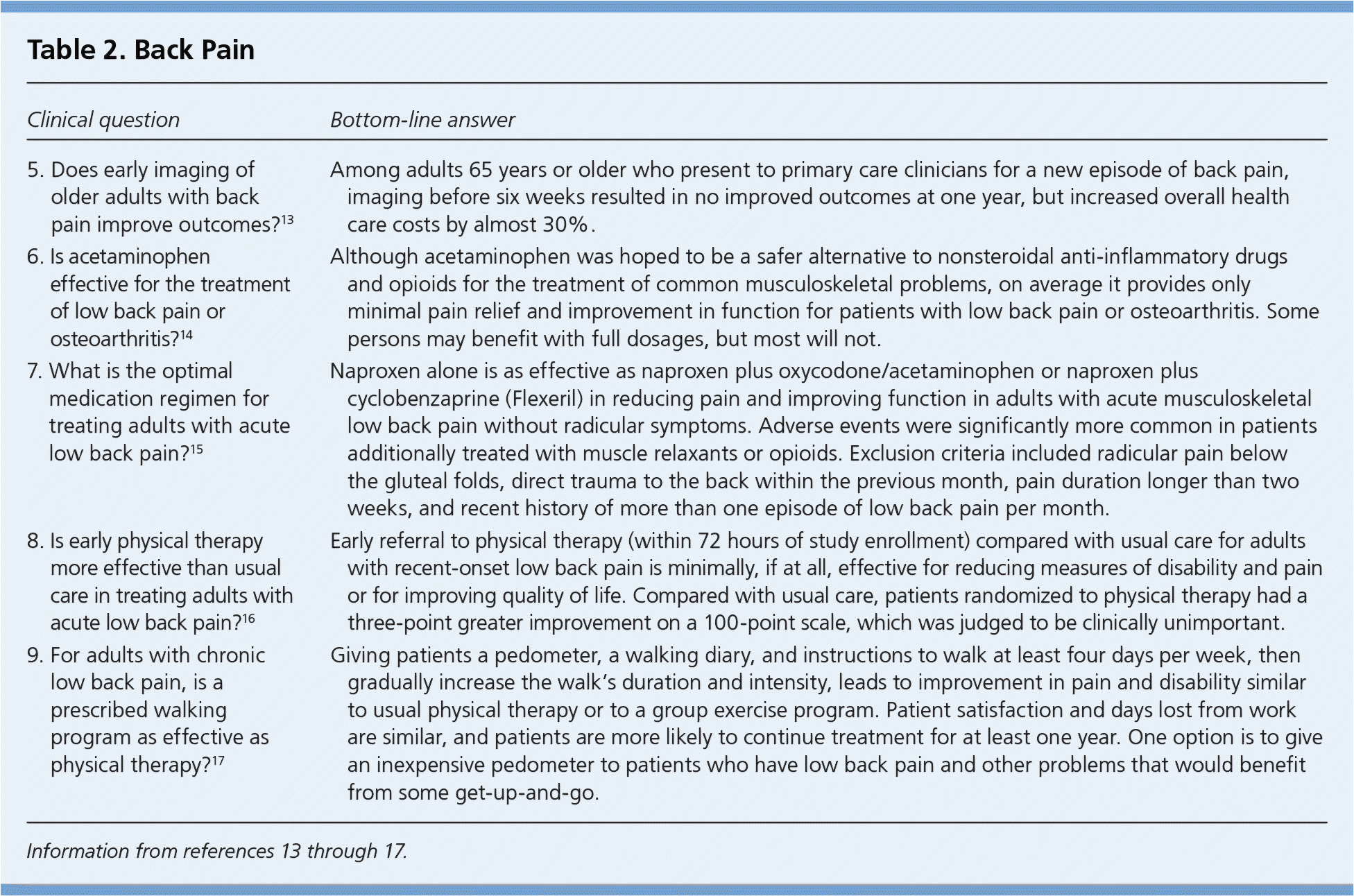
| Clinical question | Bottom-line answer |
|---|---|
| 5. Does early imaging of older adults with back pain improve outcomes?13 | Among adults 65 years or older who present to primary care clinicians for a new episode of back pain, imaging before six weeks resulted in no improved outcomes at one year, but increased overall health care costs by almost 30%. |
| 6. Is acetaminophen effective for the treatment of low back pain or osteoarthritis?14 | Although acetaminophen was hoped to be a safer alternative to nonsteroidal anti-inflammatory drugs and opioids for the treatment of common musculoskeletal problems, on average it provides only minimal pain relief and improvement in function for patients with low back pain or osteoarthritis. Some persons may benefit with full dosages, but most will not. |
| 7. What is the optimal medication regimen for treating adults with acute low back pain?15 | Naproxen alone is as effective as naproxen plus oxycodone/acetaminophen or naproxen plus cyclobenzaprine (Flexeril) in reducing pain and improving function in adults with acute musculoskeletal low back pain without radicular symptoms. Adverse events were significantly more common in patients additionally treated with muscle relaxants or opioids. Exclusion criteria included radicular pain below the gluteal folds, direct trauma to the back within the previous month, pain duration longer than two weeks, and recent history of more than one episode of low back pain per month. |
| 8. Is early physical therapy more effective than usual care in treating adults with acute low back pain?16 | Early referral to physical therapy (within 72 hours of study enrollment) compared with usual care for adults with recent-onset low back pain is minimally, if at all, effective for reducing measures of disability and pain or for improving quality of life. Compared with usual care, patients randomized to physical therapy had a three-point greater improvement on a 100-point scale, which was judged to be clinically unimportant. |
| 9. For adults with chronic low back pain, is a prescribed walking program as effective as physical therapy?17 | Giving patients a pedometer, a walking diary, and instructions to walk at least four days per week, then gradually increase the walk's duration and intensity, leads to improvement in pain and disability similar to usual physical therapy or to a group exercise program. Patient satisfaction and days lost from work are similar, and patients are more likely to continue treatment for at least one year. One option is to give an inexpensive pedometer to patients who have low back pain and other problems that would benefit from some get-up-and-go. |
Back pain was a popular topic, with five studies addressing its diagnosis and treatment (Table 2).13–17 Study 5 included 5,239 adults 65 years and older presenting to a primary care physician with a new episode of acute low back pain, of whom about one-fourth received imaging within six weeks of presentation (1,174 had plain film radiography and 349 had computed tomography or magnetic resonance imaging).13 Propensity score matching, which matches patients who did and did not undergo imaging but were otherwise similar, was used to compare outcomes between patients. Although imaging increased costs, no clinical benefit was observed.
Two studies looked at common medical treatments for back pain. Study 6 was a systematic review that identified 13 good-quality randomized controlled trials (RCTs) comparing adequate dosages of acetaminophen with placebo, and found no clinically important short- or long-term benefits for patients with back pain, hip pain, or osteoarthritis.14 This is disappointing, given the safety of acetaminophen compared with other drugs. Study 7 was an RCT of 323 adults with acute low back pain randomized to naproxen plus either placebo, cyclobenzaprine (Flexeril; 5 mg), or oxycodone/acetaminophen (5 mg/325 mg), all taken as one or two tablets every eight hours.15 Adding cyclobenzaprine or oxycodone/acetaminophen did not improve any outcomes, but led to more adverse effects (number needed to harm of 8 for the former and 5 for the latter).
What about nondrug therapies? In Study 8, which was an RCT of 220 adults with acute low back pain presenting to their primary care physician, one-half of patients were randomized to receive a referral within 72 hours for physical therapy (PT), whereas the remainder received usual care.16 The primary outcome was the Oswestry Disability Index, a 100-point measure of disability from back pain. Those receiving PT had a slightly greater improvement in the score (three points), but such a small improvement is unlikely to be noticeable by patients. There were some minor improvements on secondary outcomes, but the overall results do not support routine referral of patients with acute low back pain for PT. Finally, back pain often becomes chronic or recurrent. Study 9 was an Irish study that randomized 246 patients referred for PT to standard PT, a weekly exercise class tailored to patients with back pain, or a program of gradually increased walking.17 Patients in the walking group were given a pedometer and told to walk at least 10 minutes per day, four days per week, increasing gradually to a target of 30 minutes per day for five days per week. The walkers achieved the best results of the three groups, with the lowest cost and greatest likelihood of sustained adherence to the program. Now, we just need to advocate for our communities to offer safe places to walk.
Screening and Prevention
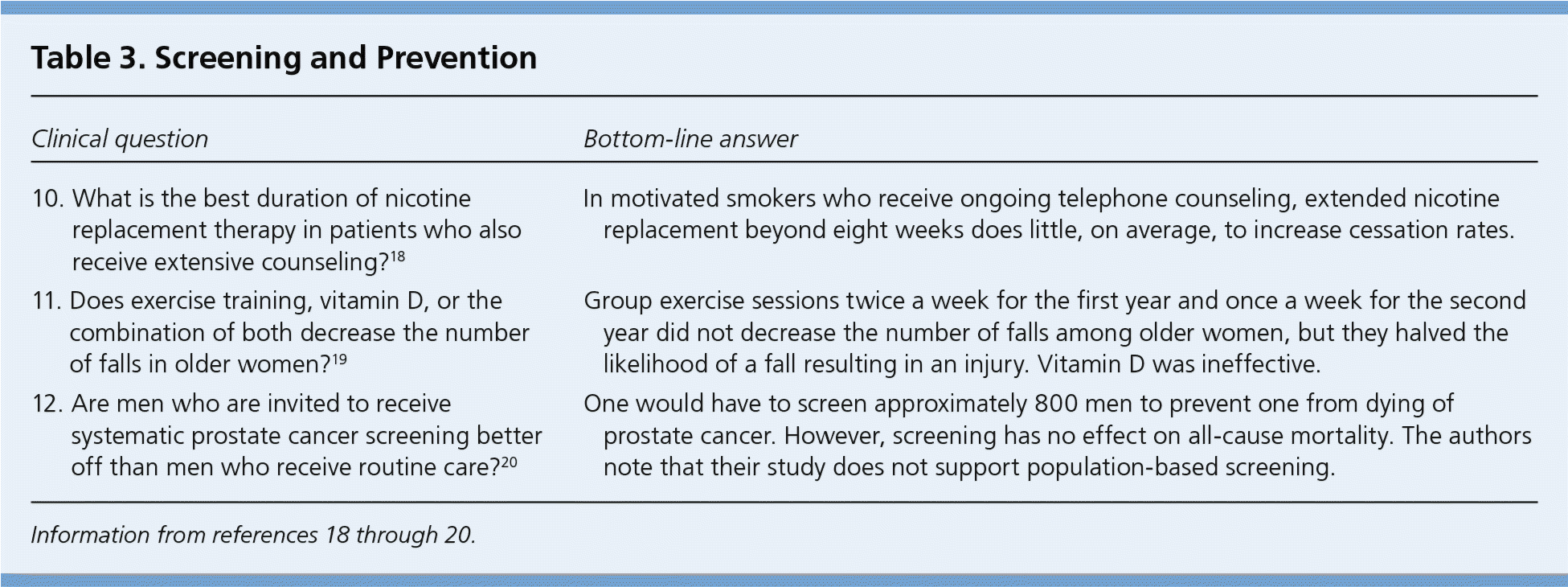
| Clinical question | Bottom-line answer |
|---|---|
| 10. What is the best duration of nicotine replacement therapy in patients who also receive extensive counseling?18 | In motivated smokers who receive ongoing telephone counseling, extended nicotine replacement beyond eight weeks does little, on average, to increase cessation rates. |
| 11. Does exercise training, vitamin D, or the combination of both decrease the number of falls in older women?19 | Group exercise sessions twice a week for the first year and once a week for the second year did not decrease the number of falls among older women, but they halved the likelihood of a fall resulting in an injury. Vitamin D was ineffective. |
| 12. Are men who are invited to receive systematic prostate cancer screening better off than men who receive routine care?20 | One would have to screen approximately 800 men to prevent one from dying of prostate cancer. However, screening has no effect on all-cause mortality. The authors note that their study does not support population-based screening. |
Several trials evaluated the benefits (and harms) of clinical preventive services (Table 3).18–20 Study 10 asked how long we should continue nicotine replacement therapy.18 The researchers randomized 525 smokers to the nicotine patch for eight, 24, or 52 weeks; all received 12 counseling sessions (the first in person and the remainder by telephone). At one year, there was no significant difference between groups in abstinence rates (more than 20% for all three groups).
Falls are an important health problem, especially in older women. Study 11, a Finnish study, included 409 community-dwelling women 70 to 80 years of age who had fallen at least once in the previous year and were not taking vitamin D supplements.19 Participants were randomized to receive 800 IU of vitamin D per day, twice-weekly exercise, both interventions, or neither. Although the total number of falls did not differ between groups, the number of falls requiring medical attention was halved in those participating in the exercise program.
In Study 12, the 13-year results of the European Randomized Study of Screening for Prostate Cancer were reported.20 The percentage of men dying from prostate cancer was approximately 0.12% lower in the screened group, a number needed to screen of approximately 800. However, there was no effect on all-cause mortality. Despite its large size (182,160 men), the study was still not powered for this outcome.
Diabetes Mellitus
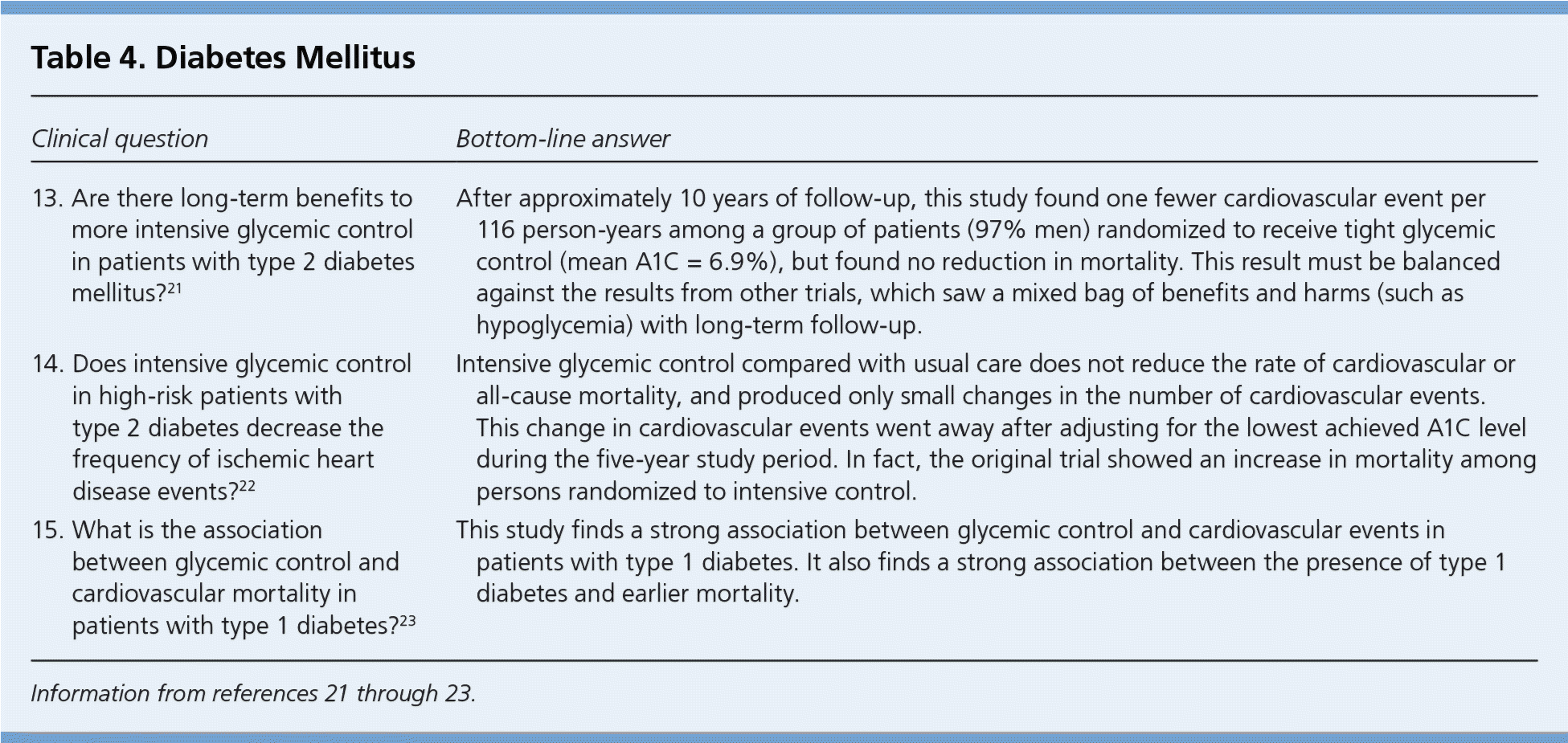
| Clinical question | Bottom-line answer |
|---|---|
| 13. Are there long-term benefits to more intensive glycemic control in patients with type 2 diabetes mellitus?21 | After approximately 10 years of follow-up, this study found one fewer cardiovascular event per 116 person-years among a group of patients (97% men) randomized to receive tight glycemic control (mean A1C = 6.9%), but found no reduction in mortality. This result must be balanced against the results from other trials, which saw a mixed bag of benefits and harms (such as hypoglycemia) with long-term follow-up. |
| 14. Does intensive glycemic control in high-risk patients with type 2 diabetes decrease the frequency of ischemic heart disease events?22 | Intensive glycemic control compared with usual care does not reduce the rate of cardiovascular or all-cause mortality, and produced only small changes in the number of cardiovascular events. This change in cardiovascular events went away after adjusting for the lowest achieved A1C level during the five-year study period. In fact, the original trial showed an increase in mortality among persons randomized to intensive control. |
| 15. What is the association between glycemic control and cardiovascular mortality in patients with type 1 diabetes?23 | This study finds a strong association between glycemic control and cardiovascular events in patients with type 1 diabetes. It also finds a strong association between the presence of type 1 diabetes and earlier mortality. |
Although intensive glycemic control has long been recommended for patients with type 2 diabetes mellitus, recent studies found benefits and harms (Table 4).21–23 Study 13, the Veterans Affairs Diabetes Trial, randomized 1,791 veterans with type 2 diabetes to intensive or usual glycemic control, with average A1C values of 6.9% and 8.4%, respectively.21 The original study found no difference in cardiovascular events or mortality between groups. The current study reports a longer follow-up of 10 years for cardiovascular events and 12 years for overall mortality. The researchers found an NNT of 116 persons per year to prevent a composite of cardiovascular events (largely because of fewer nonfatal myocardial infarctions), but no difference in the likelihood of cardiovascular death or all-cause mortality. Study 14 provided a longer-term observational follow-up of participants from the Action to Control Cardiovascular Risk in Diabetes (ACCORD) trial, and found similar small reductions in the likelihood of cardiovascular events.22 However, it is important to remember that the ACCORD trial was stopped early because a data safety and monitoring committee detected a clinically and statistically significant increase in cardiovascular and all-cause mortality in the intensive glycemic control group.
The story is somewhat different for patients with type 1 diabetes. In Study 15, a Swedish study used a registry of patients with type 1 diabetes to demonstrate a strong association between better glycemic control and lower cardiovascular mortality. Even for those with excellent glycemic control, though, cardiovascular mortality was higher than for persons without type 1 diabetes.23
Cardiovascular Disease
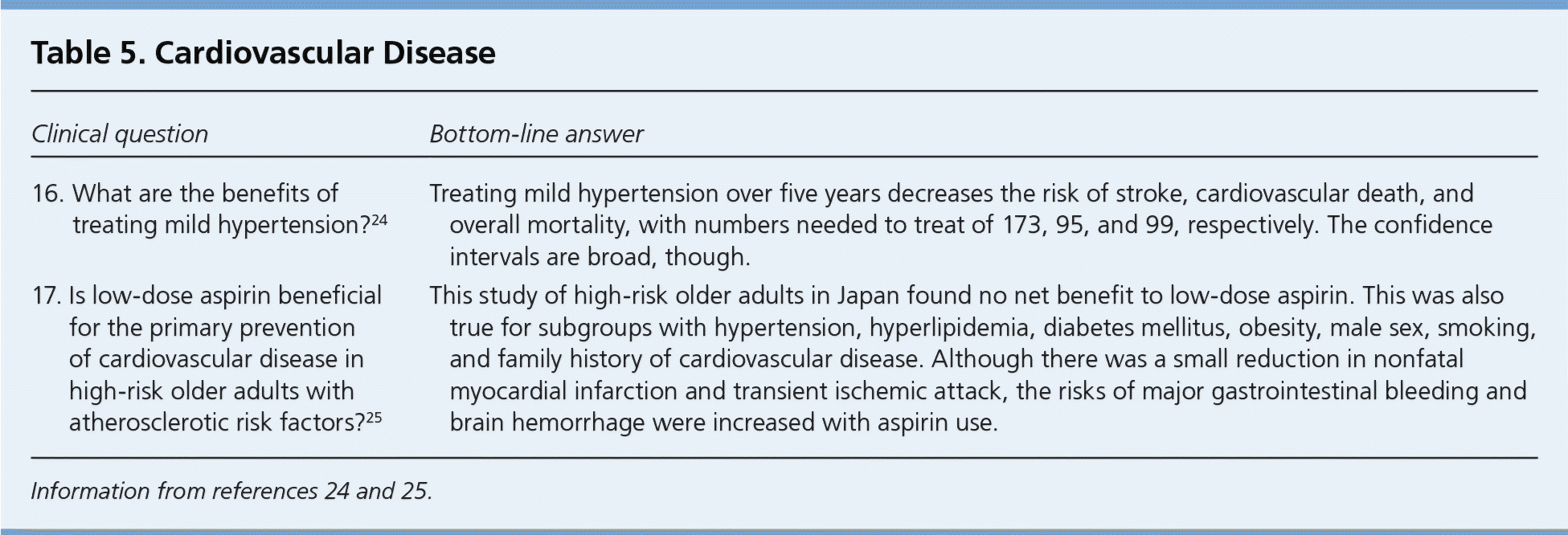
| Clinical question | Bottom-line answer |
|---|---|
| 16. What are the benefits of treating mild hypertension?24 | Treating mild hypertension over five years decreases the risk of stroke, cardiovascular death, and overall mortality, with numbers needed to treat of 173, 95, and 99, respectively. The confidence intervals are broad, though. |
| 17. Is low-dose aspirin beneficial for the primary prevention of cardiovascular disease in high-risk older adults with atherosclerotic risk factors?25 | This study of high-risk older adults in Japan found no net benefit to low-dose aspirin. This was also true for subgroups with hypertension, hyperlipidemia, diabetes mellitus, obesity, male sex, smoking, and family history of cardiovascular disease. Although there was a small reduction in nonfatal myocardial infarction and transient ischemic attack, the risks of major gastrointestinal bleeding and brain hemorrhage were increased with aspirin use. |
The first of two cardiovascular studies (Table 524,25 ) examined the effectiveness of treatment for mild hypertension (140/90 to 159/99 mm Hg). Most systematic reviews combine the aggregate data from studies, but the researchers in Study 16 were able to use individual patient-level data for 15,266 patients randomized to active treatment or placebo.24 Over an average five years of treatment, the NNT to prevent one stroke was 173 (95% confidence interval [CI], 108 to 810), to prevent one cardiovascular death was 95 (95% CI, 55 to 1,188), and to prevent one death overall was 99 (95% CI, 66 to 273). These estimates are clinically and statistically significant, but the CIs are wide.
A 2011 meta-analysis of nine studies with more than 100,000 participants found fewer major cardiovascular events (NNT = 253 over seven years) but more major bleeding complications (number needed to harm = 261 over seven years) for patients without known cardiovascular disease who were randomized to aspirin as primary prevention.26 Study 17 was a large Japanese trial that randomized adults 60 years and older with cardiovascular risk factors but no known cardiovascular disease to aspirin or control and then followed them for five years.25 There were fewer nonfatal myocardial infarctions and transient ischemic attacks in the treatment group, but there were also more bleeding complications and no difference in all-cause mortality. Overall, the authors concluded that there was no net benefit of aspirin.
Miscellaneous
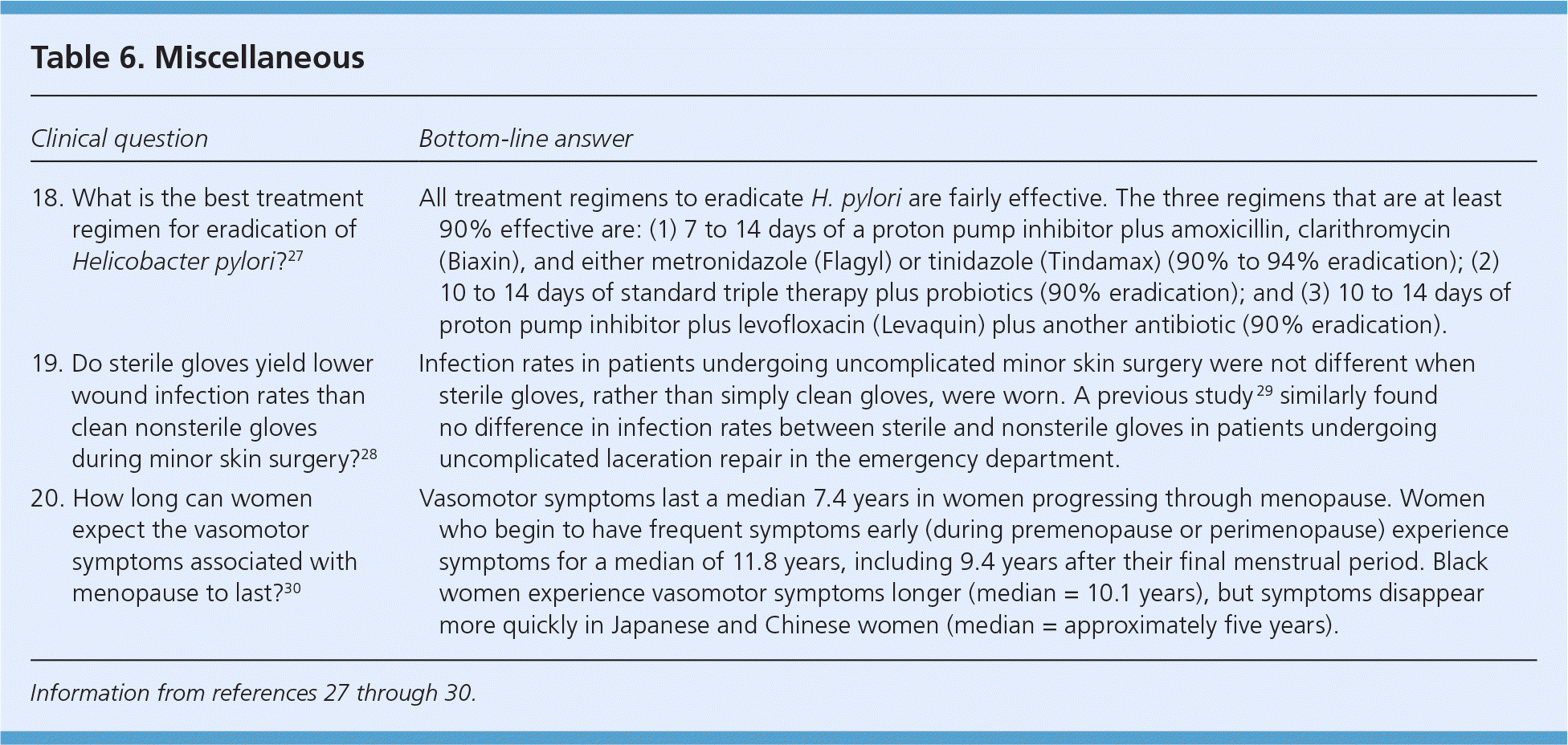
| Clinical question | Bottom-line answer |
|---|---|
| 18. What is the best treatment regimen for eradication of Helicobacter pylori?27 | All treatment regimens to eradicate H. pylori are fairly effective. The three regimens that are at least 90% effective are: (1) 7 to 14 days of a proton pump inhibitor plus amoxicillin, clarithromycin (Biaxin), and either metronidazole (Flagyl) or tinidazole (Tindamax) (90% to 94% eradication); (2) 10 to 14 days of standard triple therapy plus probiotics (90% eradication); and (3) 10 to 14 days of proton pump inhibitor plus levofloxacin (Levaquin) plus another antibiotic (90% eradication). |
| 19. Do sterile gloves yield lower wound infection rates than clean nonsterile gloves during minor skin surgery?28 | Infection rates in patients undergoing uncomplicated minor skin surgery were not different when sterile gloves, rather than simply clean gloves, were worn. A previous study 29 similarly found no difference in infection rates between sterile and nonsterile gloves in patients undergoing uncomplicated laceration repair in the emergency department. |
| 20. How long can women expect the vasomotor symptoms associated with menopause to last?30 | Vasomotor symptoms last a median 7.4 years in women progressing through menopause. Women who begin to have frequent symptoms early (during premenopause or perimenopause) experience symptoms for a median of 11.8 years, including 9.4 years after their final menstrual period. Black women experience vasomotor symptoms longer (median = 10.1 years), but symptoms disappear more quickly in Japanese and Chinese women (median = approximately five years). |
Several top POEMs did not fit into one of the previous categories, but they provide important guidance for family physicians (Table 6).27–30 Study 18 is a systematic review of 143 studies comparing 14 different regimens with standard triple therapy (a proton pump inhibitor plus clarithromycin [Biaxin] plus either metronidazole [Flagyl] or amoxicillin) for Helicobacter pylori eradication.27 Three regimens, described in Table 6,27–30 emerged as more effective than the others. Study 19 included 493 patients presenting to a primary care practice in Australia who were randomized to minor skin surgery with sterile gloves vs. boxed, nonsterilized gloves.28 There was no difference in the likelihood of infection (9.3% in those treated with sterile gloves vs. 8.7% in those treated with nonsterile gloves). Finally, Study 20, a population-based prospective cohort study, followed 1,449 women 42 to 52 years of age to determine the duration of vasomotor symptoms during menopause.30 The duration was longer for women whose symptoms began before menopause compared with those whose symptoms began after menopause (11.8 vs. 3.4 years). This information allows family physicians to better advise their patients.
Guidelines
These top 20 POEMs are based on an original research study or systematic review. Several POEMs that summarized practice guidelines were also highly rated. Guidelines from the U.S. Preventive Services Task Force included recommendations to not screen for thyroid disease,31 to confirm the diagnosis of mild to moderate hypertension with ambulatory or home blood pressure monitoring,32 and to screen patients who are obese for diabetes.33 The American College of Physicians released guidelines that recommended against screening adults not at increased risk of cardiovascular disease,34 and largely affirmed the recommendations of other organizations regarding cervical cancer screening.35
The Department of Veterans Affairs and the Department of Defense have created guidelines for the use of lipid-lowering therapies36 that are somewhat less aggressive than those of the American College of Cardiology and the American Heart Association (ACC/AHA),37 recommending therapy for those with a 12% or higher 10-year risk of cardiovascular events, shared decision making for those between 6% and 12%, and no therapy for those with a 10-year risk less than 6%. They also recommend using a moderate, fixed-dose statin for most patients and not checking or following lipid levels.
Finally, the ACC/AHA guidelines on atrial fibrillation recommend that physicians use the CHA2DS2-VASc score (congestive heart failure; hypertension; age 75 years or older; diabetes; prior stroke, transient ischemic attack, or thromboembolism; vascular disease; age 65 to 74 years; sex category) to assess risk, prescribe warfarin (Coumadin) or novel oral anticoagulants, and consider rate control as an option.38 The novel oral anticoagulants provide greater convenience with greater cost.
editor's note: This article was cowritten by Dr. Mark Ebell, who was a member of the U.S. Preventive Services Task Force (USPSTF) from 2012 to 2015 and currently serves as a consultant to the USPSTF. This article does not necessarily represent the views and policies of the USPSTF. Dr. Ebell is deputy editor for American Family Physician (AFP) and cofounder and editor-in-chief of Essential Evidence Plus, published by Wiley-Blackwell, Inc. The POEMs described in this article stem from work that Dr. Ebell and his colleagues have been doing for the past two decades. Medical journals occasionally publish an article summarizing the best studies in a certain field from the previous year; however, those articles are limited by being one person's idiosyncratic collection of a handful of studies. In contrast, this article by Drs. Ebell and Roland Grad is validated in two ways: (1) the source material (POEMs) was derived from a systematic review of thousands of articles using a rigorous criterion-based process, and (2) these “best of the best” summaries were rated by thousands of Canadian primary care physicians for relevance and benefits to practice.
Because of Dr. Ebell's dual roles and ties to Essential Evidence Plus, the concept for this article was independently reviewed and approved by a group of AFP's medical editors. In addition, the article underwent peer review and editing by four of AFP's medical editors. Dr. Ebell was not involved in the editorial decision-making process.—Jay Siwek, MD, Editor, American Family Physician
The authors thank Wiley-Blackwell, Inc., for giving permission to excerpt the POEMs; Drs. Allen Shaughnessy, Henry Barry, David Slawson, Nita Kulkarni, and Linda Speer for their work in selecting and writing the original POEMs; the academic family medicine fellows and faculty of the University of Missouri–Columbia, for their work as peer reviewers; Pierre Pluye, PhD, for his work in codeveloping the Information Assessment Method; and Maria Vlasak for her assistance with copyediting the POEMs for the past 22 years.